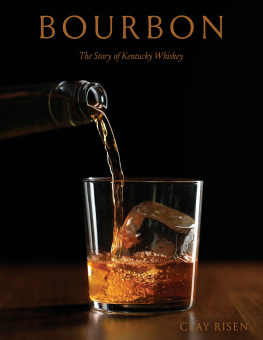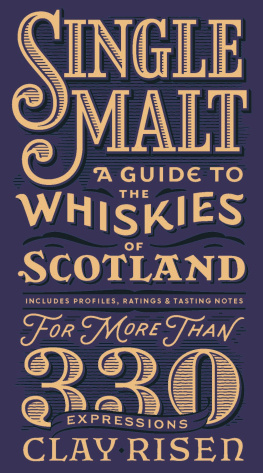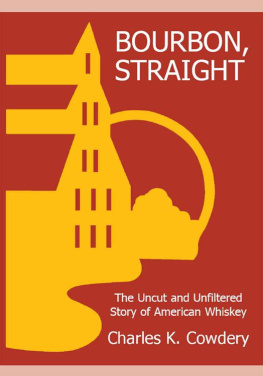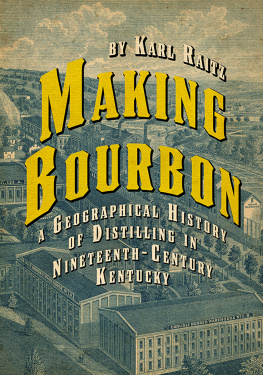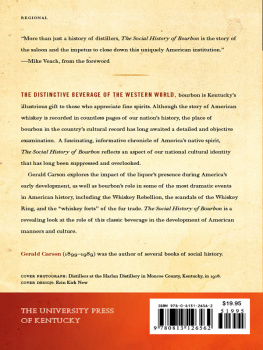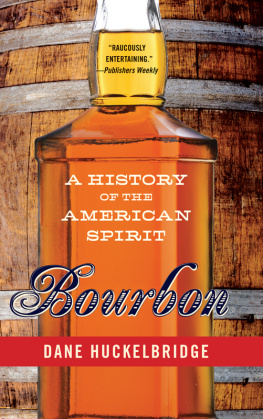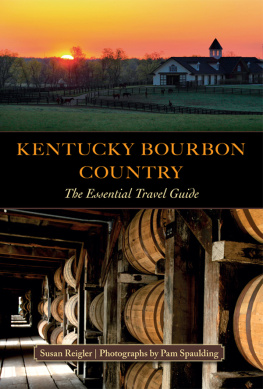Contents
Landmarks
Print Page List
ACKNOWLEDGMENTS
No matter how reclusive an author may try to be, every book requires the work of countless people, which is what makes acknowledgments so hard to write. What author wants to risk leaving someone out? Despite that possibility, Id like to thank the following folks, with the humble request that if I did leave out anyone, it was an honest mistake.
First comes the team at Ten Speed Press, who made this book happen in the first place: Lorena Jones, who came up with the idea and roped me into writing it; Shaida Boroumand, who guided me through the writing and editing; Annie Marino and Emma Campion, ace art directors if Ive ever met one; Jane Chinn, who oversaw production and made sure all the puzzle pieces came together; and Doug Ogan, whose copyediting skills saved me from more errors than Id care to admit.
Luke Sharretts photography made this book what it is, and Peter Voth crafted a map that both clarifies the landscape of Kentucky distilling and brings it to life.
The list of people who took the time to speak with me about the book is too long to fit here; you know who you are, and I hope you know how much I appreciate you. For making some of those conversations possible, I would especially like to thank June Alian, Laura Baddish, Sarah Bessette, Aaron Brost, Lauren Cherry, Gabby Deitsch, Allison Fleischer, Sallie Gardner, Tara Malega, Suzanne Pace, Blair Peterson, Amy Preske, Pia Reinhold, and Alexis Stathis Tsao.
Several friends read all or some of the manuscript, and their comments made the book significantly better: Jim Goodman, David Greenberg, Howard Levinson, Michael Massing, Reid Mitenbuler, Natalia Petrzela, Claire Potter, and James Traub.
Thanks as well to Heather Schroder, my agent, who made this whole arrangement possible. And finally, thanks to my wife, Joanna, and our children, Talia and Elliot, who suffered through said arrangement. As with everything, I could not have done it without you.
ABOUT THE CONTRIBUTORS

CLAY RISEN
CLAY RISEN ranks among the countrys leading experts on whiskey and other distilled spirits. He is the author of the bestselling American Whiskey , Bourbon & Rye: A Guide to the Nations Favorite Spirit , Single Malt: A Guide to the Whiskies of Scotland , and The Impossible Collection of Whiskey . Risen writes about whiskey for the New York Times , where he is an editor and reporter, and he sits on the tasting panel for the Ultimate Spirits Challenge, one of the worlds most prestigious spirits competitions.
Risen is also the author of several acclaimed books about American history, including The Crowded Hour: Theodore Roosevelt , the Rough Riders, and the Dawn of the American Century , which was a New York Times notable book for 2019; The Bill of the Century: The Epic Battle for the Civil Rights Act ; and A Nation on Fire: America in the Wake of the King Assassination . He was born in Upstate New York, grew up in Nashville, and now lives in Brooklyn with his wife and two children.

LUKE SHARRETT
LUKE SHARRETT is a photographer based in Louisville, Kentucky. He spent the past decade covering the White House for the New York Times , traveling aboard Air Force One, and reporting on hurricanes. In his spare time, when not wrestling with his two sons, he can be found re-enacting World War II battles and parachuting from vintage warbirds.
GLOSSARY
Distilling is both a science and a traditional craft, two fields that give rise to dense thickets of arcane and technical terms. Here are some definitions to help you better explore.
ALCOHOL BY VOLUME: The amount of alcohol in whiskey as a percentage of the total volume.
ANGELS SHARE: Whiskey barrels are both airtight and, since they are made of wood, permeable. Over time, the wood absorbs alcohol and water, which evaporates out of the barrel at a rate of about 5 percent a year. This is the angels share.
BACKSET: The spent mash, left over from distillation. In the sour-mash process, a portion of it is added to the next batch of mash.
BARREL: A watertight wooden container made of curved staves bound by metal hoops, sealed with round wooden heads at each end. Barrels are mostly used to age wine, beer, whiskey, and other spirits. Though federal law only requires whiskey to be aged in a charred new oak container, in practice it is always a barrel. In the United States, the standard barrel holds fifty-three gallons.
BARREL PROOF: Literally the proof at which a whiskey comes out of the barrel. Distilleries will sometimes offer a whiskey at barrel proof, though some use the term flexibly, to designate any high-proof release, even one that has been cut with some water. The term is interchangeable with barrel strength or cask strength.
BEER: In this book, it usually refers to the goopy result of fermenting a mash of grain and water.
BOTTLED IN BOND: Whiskey that has been produced according to the Bottled in Bond Act of 1897. It has five requirements. The whiskey must be at least four years old, it must be bottled at 100 proof, it must be made by a single distiller at a single distillery, it can contain no additives, and it must be the product of a single distilling season. The label has to provide all this information, and only whiskey made in the United States qualifies. Bottled in Bond quickly became a designation of quality, a sort of federal seal of approval.
CHAR: Charring involves momentarily setting the interior of a barrel on fire, which has several advantages. The result, the char, acts as a filter, removing unwanted compounds from a whiskey. It also imparts color, caramelizes sugars locked in the red layer deep within the wood, and provides a pathway for the whiskey to access those sugars. Char does not, however, provide much flavor, since most of the sugars and other compounds in the char layer are destroyed in the process.
COLUMN STILL: Also known as a continuous still, it is a hollow column, in which steam pumped into the bottom rises to meet the beer poured in near the top. Perforated plates along the way slow the beers descent, allowing the steam time to vaporize the alcohol and, depending on the arrangement of the plates, more or less of the water and other compounds in the beer. The vapor rises to the top of the still and out into a condenser, where it turns back into liquid. A column still is usually paired with a doubler, which purifies the distillate further.
CUTS: Distillers divide the spirit coming off a still into three sequential sections: heads, hearts, and tails, sometimes called feints. (They are preceded by the foreshots, which are usually discarded.)
DISTILLATION: In the case of whiskey-making, it is the process of purifying components of the fermented mash (also called distillers beer) by vaporizing and condensing it. Because different constituent liquids boil at different temperatures, they can be separated by adjusting the level of heat.
DOUBLER: A still used to further concentrate ethanol after the primary distillation, typically on a column still. Doublers are much smaller than column stills, and come in a variety of styles ( see Thumper).
ESTER: A type of compound produced throughout the fermentation, distillation, and maturation process. Esters, hundreds of which have been identified in whiskey, play an important role in shaping aromas and flavors.
EXPRESSION: Distilleries will often release several versions of the same basic whiskey, varying things such as age, proof, and finishing. Each of these is a different expression.

